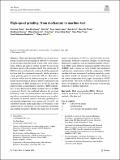| dc.contributor.author | Wang, Yu-Long | |
| dc.contributor.author | Zhang, Yan-Bin | |
| dc.contributor.author | Cui, Xin | |
| dc.contributor.author | Liang, Xiao-Liang | |
| dc.contributor.author | Li, Run-Ze | |
| dc.contributor.author | Wang, Ruo-Xin | |
| dc.contributor.author | Sharma, Shubham | |
| dc.contributor.author | Liu, Ming-Zheng | |
| dc.contributor.author | Gao, Teng | |
| dc.contributor.author | Zhou, Zong-Ming | |
| dc.contributor.author | Wang, Xiao-Ming | |
| dc.contributor.author | Dambatta, Yusuf S. | |
| dc.contributor.author | Li, Chang-He | |
| dc.date.accessioned | 2024-10-21T20:08:50Z | |
| dc.date.available | 2024-10-21T20:08:50Z | |
| dc.date.issued | 2024-10-05 | |
| dc.identifier.uri | https://hdl.handle.net/1721.1/157395 | |
| dc.description.abstract | High-speed grinding (HSG) is an advanced technology for precision machining of difficult-to-cut materials in aerospace and other fields, which could solve surface burns, defects and improve surface integrity by increasing the linear speed of the grinding wheel. The advantages of HSG have been preliminarily confirmed and the equipment has been built for experimental research, which can achieve a high grinding speed of more than 300 m/s. However, it is not yet widely used in manufacturing due to the insufficient understanding on material removal mechanism and characteristics of HSG machine tool. To fill this gap, this paper provides a comprehensive overview of HSG technologies. A new direction for adding auxiliary process in HSG is proposed. Firstly, the combined influence law of strain hardening, strain rate intensification, and thermal softening effects on material removal mechanism was revealed, and models of material removal strain rate, grinding force and grinding temperature were summarized. Secondly, the constitutive models under high strain rate boundaries were summarized by considering various properties of material and grinding parameters. Thirdly, the change law of material removal mechanism of HSG was revealed when the thermodynamic boundary conditions changed, by introducing lubrication conditions such as minimum quantity lubrication (MQL), nano-lubricant minimum quantity lubrication (NMQL) and cryogenic air (CA). Finally, the mechanical and dynamic characteristics of the key components of HSG machine tool were summarized, including main body, grinding wheel, spindle and dynamic balance system. Based on the content summarized in this paper, the prospect of HSG is put forward. This study establishes a solid foundation for future developments in the field and points to promising directions for further exploration. | en_US |
| dc.publisher | Shanghai University | en_US |
| dc.relation.isversionof | https://doi.org/10.1007/s40436-024-00508-x | en_US |
| dc.rights | Creative Commons Attribution | en_US |
| dc.rights.uri | https://creativecommons.org/licenses/by/4.0/ | en_US |
| dc.source | Springer Nature | en_US |
| dc.title | High-speed grinding: from mechanism to machine tool | en_US |
| dc.type | Article | en_US |
| dc.identifier.citation | Wang, YL., Zhang, YB., Cui, X. et al. High-speed grinding: from mechanism to machine tool. Adv. Manuf. (2024). | en_US |
| dc.contributor.department | Massachusetts Institute of Technology. Department of Mechanical Engineering | en_US |
| dc.relation.journal | Advances in Manufacturing | en_US |
| dc.eprint.version | Final published version | en_US |
| dc.type.uri | http://purl.org/eprint/type/JournalArticle | en_US |
| eprint.status | http://purl.org/eprint/status/PeerReviewed | en_US |
| dc.date.updated | 2024-10-06T03:14:23Z | |
| dc.language.rfc3066 | en | |
| dc.rights.holder | The Author(s) | |
| dspace.date.submission | 2024-10-06T03:14:23Z | |
| mit.license | PUBLISHER_CC | |
| mit.metadata.status | Authority Work and Publication Information Needed | en_US |
